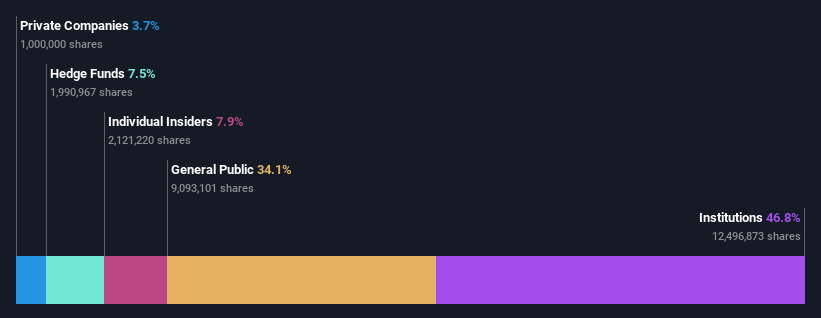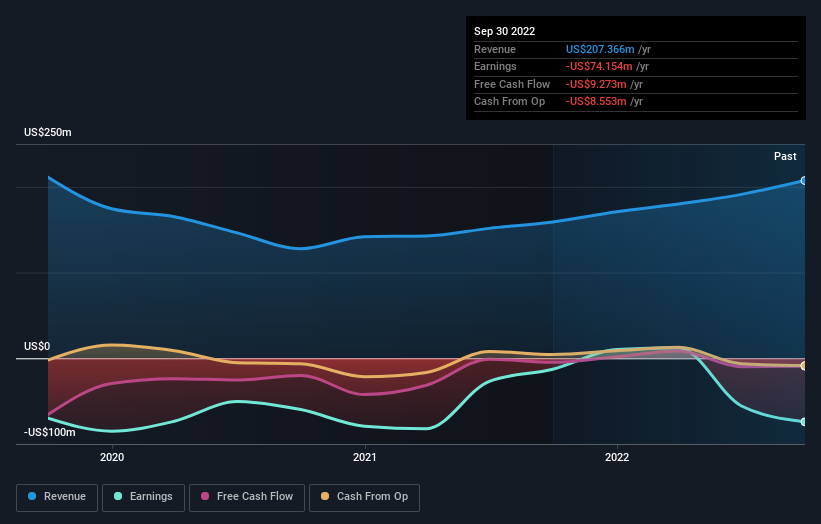SEACOR Marine Holdings Inc.'s (NYSE:SMHI) high institutional ownership speaks for itself as stock continues to impress, up 11% over last week
Key Insights
Institutions' substantial holdings in SEACOR Marine Holdings implies that they have significant influence over the company's share price
The top 9 shareholders own 50% of the company
Using data from company's past performance alongside ownership research, one can better assess the future performance of a company
Every investor in SEACOR Marine Holdings Inc. (NYSE:SMHI) should be aware of the most powerful shareholder groups. We can see that institutions own the lion's share in the company with 47% ownership. In other words, the group stands to gain the most (or lose the most) from their investment into the company.
And things are looking up for institutional investors after the company gained US$29m in market cap last week. The gains from last week would have further boosted the one-year return to shareholders which currently stand at 104%.
Let's take a closer look to see what the different types of shareholders can tell us about SEACOR Marine Holdings.
See our latest analysis for SEACOR Marine Holdings
What Does The Institutional Ownership Tell Us About SEACOR Marine Holdings?
Institutions typically measure themselves against a benchmark when reporting to their own investors, so they often become more enthusiastic about a stock once it's included in a major index. We would expect most companies to have some institutions on the register, especially if they are growing.
We can see that SEACOR Marine Holdings does have institutional investors; and they hold a good portion of the company's stock. This suggests some credibility amongst professional investors. But we can't rely on that fact alone since institutions make bad investments sometimes, just like everyone does. It is not uncommon to see a big share price drop if two large institutional investors try to sell out of a stock at the same time. So it is worth checking the past earnings trajectory of SEACOR Marine Holdings, (below). Of course, keep in mind that there are other factors to consider, too.
Our data indicates that hedge funds own 7.5% of SEACOR Marine Holdings. That worth noting, since hedge funds are often quite active investors, who may try to influence management. Many want to see value creation (and a higher share price) in the short term or medium term. T. Rowe Price Group, Inc. is currently the largest shareholder, with 18% of shares outstanding. With 7.5% and 4.5% of the shares outstanding respectively, Flat Footed LLC and The Carlyle Group Inc. are the second and third largest shareholders. Additionally, the company's CEO John Gellert directly holds 3.5% of the total shares outstanding.
We did some more digging and found that 9 of the top shareholders account for roughly 50% of the register, implying that along with larger shareholders, there are a few smaller shareholders, thereby balancing out each others interests somewhat.
Researching institutional ownership is a good way to gauge and filter a stock's expected performance. The same can be achieved by studying analyst sentiments. Our information suggests that there isn't any analyst coverage of the stock, so it is probably little known.
Insider Ownership Of SEACOR Marine Holdings
The definition of company insiders can be subjective and does vary between jurisdictions. Our data reflects individual insiders, capturing board members at the very least. Company management run the business, but the CEO will answer to the board, even if he or she is a member of it.
I generally consider insider ownership to be a good thing. However, on some occasions it makes it more difficult for other shareholders to hold the board accountable for decisions.
Our most recent data indicates that insiders own some shares in SEACOR Marine Holdings Inc.. In their own names, insiders own US$24m worth of stock in the US$296m company. This shows at least some alignment. You can click here to see if those insiders have been buying or selling.
General Public Ownership
The general public, who are usually individual investors, hold a 34% stake in SEACOR Marine Holdings. While this group can't necessarily call the shots, it can certainly have a real influence on how the company is run.
Private Company Ownership
Our data indicates that Private Companies hold 3.7%, of the company's shares. Private companies may be related parties. Sometimes insiders have an interest in a public company through a holding in a private company, rather than in their own capacity as an individual. While it's hard to draw any broad stroke conclusions, it is worth noting as an area for further research.
Next Steps:
I find it very interesting to look at who exactly owns a company. But to truly gain insight, we need to consider other information, too. Take risks for example - SEACOR Marine Holdings has 1 warning sign we think you should be aware of.
Of course this may not be the best stock to buy. So take a peek at this free free list of interesting companies.
NB: Figures in this article are calculated using data from the last twelve months, which refer to the 12-month period ending on the last date of the month the financial statement is dated. This may not be consistent with full year annual report figures.
Have feedback on this article? Concerned about the content? Get in touch with us directly. Alternatively, email editorial-team (at) simplywallst.com.
This article by Simply Wall St is general in nature. We provide commentary based on historical data and analyst forecasts only using an unbiased methodology and our articles are not intended to be financial advice. It does not constitute a recommendation to buy or sell any stock, and does not take account of your objectives, or your financial situation. We aim to bring you long-term focused analysis driven by fundamental data. Note that our analysis may not factor in the latest price-sensitive company announcements or qualitative material. Simply Wall St has no position in any stocks mentioned.
Join A Paid User Research Session
You’ll receive a US$30 Amazon Gift card for 1 hour of your time while helping us build better investing tools for the individual investors like yourself. Sign up here

 Yahoo Finance
Yahoo Finance 

